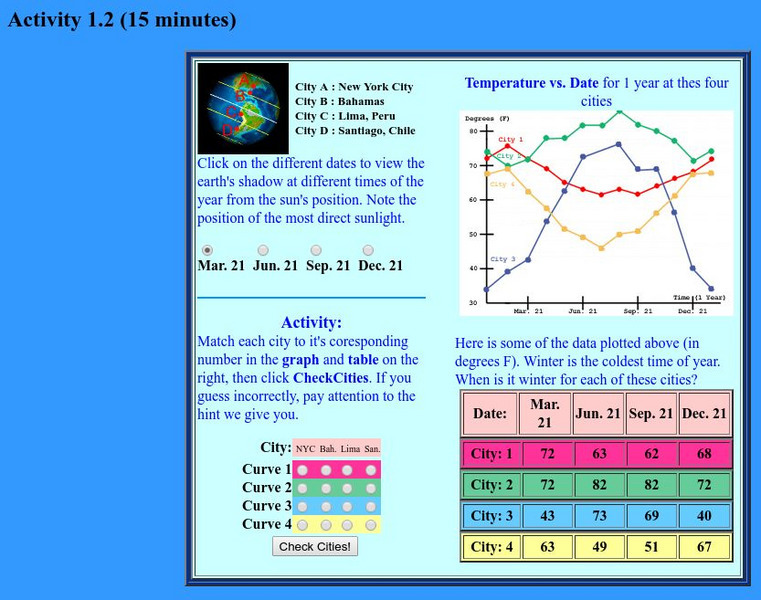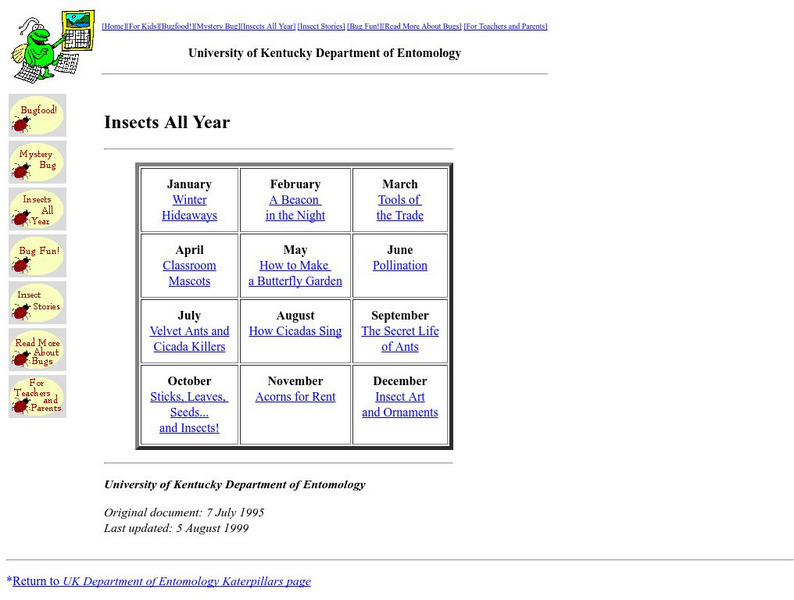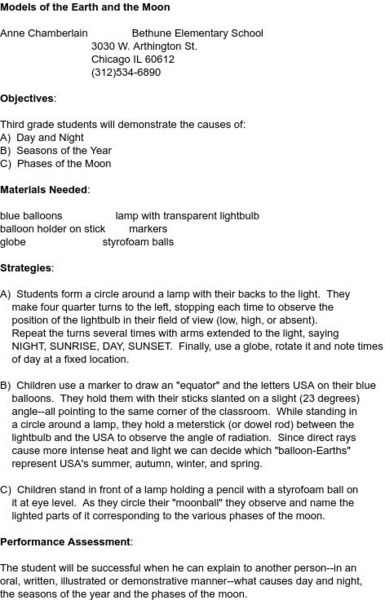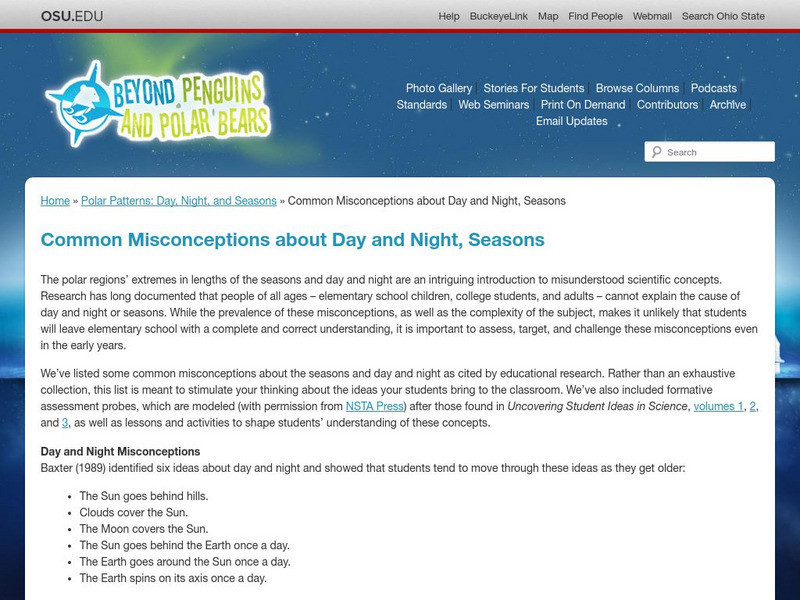BBC
Bbc Skillswise: Measuring: Time and Date
Presents facts about time and dates, how to use timetables and calculate time.
Alabama Learning Exchange
Alex: The Sun and the Earth
The students will understand the relationship between the Earth and the sun and how this relationship affects observable phenomena on Earth, such as the seasons. The activity will help students learn about these concepts and will...
Alabama Learning Exchange
Alex: What Will I Wear to School Today?
Hot, cold, windy, or snowing, students need to know how to dress appropriately. In this lesson, students will learn how weather affects what they wear to school each day. Students will practice choosing the appropriate clothing by using...
The Wonder of Science
The Wonder of Science: Ms Ess1 1: Earth Sun Moon System
Develop and use a model of the earth-sun-moon system to describe the cyclic patterns of lunar phases, eclipses of the sun and moon, and seasons.
Math Drills
Math Drills: Seasonal Math Worksheets
Download these free worksheets to sharpen your math skills. These seasonal-themed math worksheets focus on topics such as patterning, mixed operations, and addition.
Science Buddies
Science Buddies: Kinesthetic Astronomy: Longer Days, Shorter Nights
This kinesthetic activity demonstrates to students that the Earth's tilt is what is responsible for shifting light patterns and the change in seasons.
Environmental Education for Kids
Eek!: Seasonal Observations
Have you ever wondered what is going on under the snow? Why leaves change colors? How migratory birds find their way? Find the answers and check out these ideas on how to explore, discuss, or celebrate based on our four seasons!
Environmental Education for Kids
Eek!: Seasonal Observations: Winter
The shortest day of the year, or the winter solstice, marks the beginning of this season usually occurs around December 21. Bundle up because winter is a fantastic time to track animals and explore the outdoors!
Environmental Education for Kids
Eek!: Seasonal Observations: Summer
While many of us consider it summer once school is released, this season technically begins with the summer solstice - the longest day of the year - on June 21 and continues until the fall equinox in September.
Environmental Education for Kids
Eek!: Seasonal Observations: Spring
Say good-bye to cold temperatures and short days, spring is here!! Mud puddles, blossoms, songbirds are just a few things that call us outdoors during this season. Start here for some cool ideas to celebrate spring!
Environmental Education for Kids
Eek!: Seasonal Observations: Fall
Fall begins with the autumnal equinox, usually around September 22 or 23. The equinox is the time of the year when we have equal length of night and day.
PBS
Pbs Learning Media: Classroom Posters: Pbs Kids
Print and post a set of 13 early childhood posters to support your young learners. From counting 1-10, to identifying feelings, to naming the days of the week, you can leverage these PBS KIDS posters at Circle Time in Centers, and to...
PBS
Pbs Learning Media: A Peep for All Seasons
Support your Economics or History curriculum with this video that introduces students to Just Born, a candy manufacturer in Pennsylvania that is adapting its seasonal business model to changing times. Then, use the accompanying lesson...
PBS
Pbs Learning Media: Seasons on Earth and Mars
Compare the seasons on Earth and Mars with NASA imagery. Use this resource to visualize how the axial tilt of a planet influences its seasons and to compare data about seasonal changes on Earth and Mars. Support materials include:...
Louisiana Department of Education
Louisiana Doe: Louisiana Believes: Ela Unit: Grade 1: The Year at Maple Hill Farm
First graders learn about change over the course of a year, investigating and exploring the four seasons and what the changing seasons mean for humans and animals. They learn about animal behavior and patterns during the seasons,...
PBS
Pbs Learning Media: Why Do We Have Seasons?
Explore what causes seasons on Earth in this interactive adapted from NASA materials that features four cities at different latitudes. Use this resource to view how Earth's axial tilt causes seasons from different perspectives and to...
PBS
Pbs Learning Media: Daily and Seasonal Weather: Interactive Lesson
Students investigate the relationship between daily weather and seasonal weather. Students will read about how weather data is collected, then interpret examples of weekly and monthly weather data to find seasonal patterns. Visual...
E-learning for Kids
E Learning for Kids: Math: Russian Toy Store: Time and Temperature: Using a Calendar and Temperature
Irina visits her grandfather Alexander in his toy store. Join them to learn more about calendars and temperatures!
University of Utah
University of Utah: Aspire: Seasons Exercise
In this activity, use seasons to determine your location. Click on the different dates to view the earth's shadow at different times of the year from the sun's position.
University of Kentucky
University of Kentucky: Insects All Year
The University of Kentucky provides information and activities about insects for each month of the year. Projects include art and observational activities.
Science and Mathematics Initiative for Learning Enhancement (SMILE)
Smile: Models of the Earth and Moon
This lesson plan from the Illinois Institute of Technology demonstrates the causes of; day and night, seasons, and phases of the moon.With a few items, you help the elementary student discover why these phenomena occur.
Science Education Resource Center at Carleton College
Serc: Mn Step: Weather and Seasonal Cycles
For this activity, students conduct ongoing observations of the weather and seasonal changes, and record them in their weather journals.
Science Education Resource Center at Carleton College
Serc: Seasons
For this activity, young scholars create a small model of the Earth using a styrofoam ball and a skewer. They then explore the relationship between the Earth and the Sun (a flashlight) to understand why it is hottest at the Equator, and...
Ohio State University
Beyond Penguins and Polar Bears: Common Misconceptions About Day and Night
Misconceptions about the causes of seasons and day and night are common through all ages. Use the information on this site to help your students understand these concepts. Included are links to many resources and lesson plans for...












